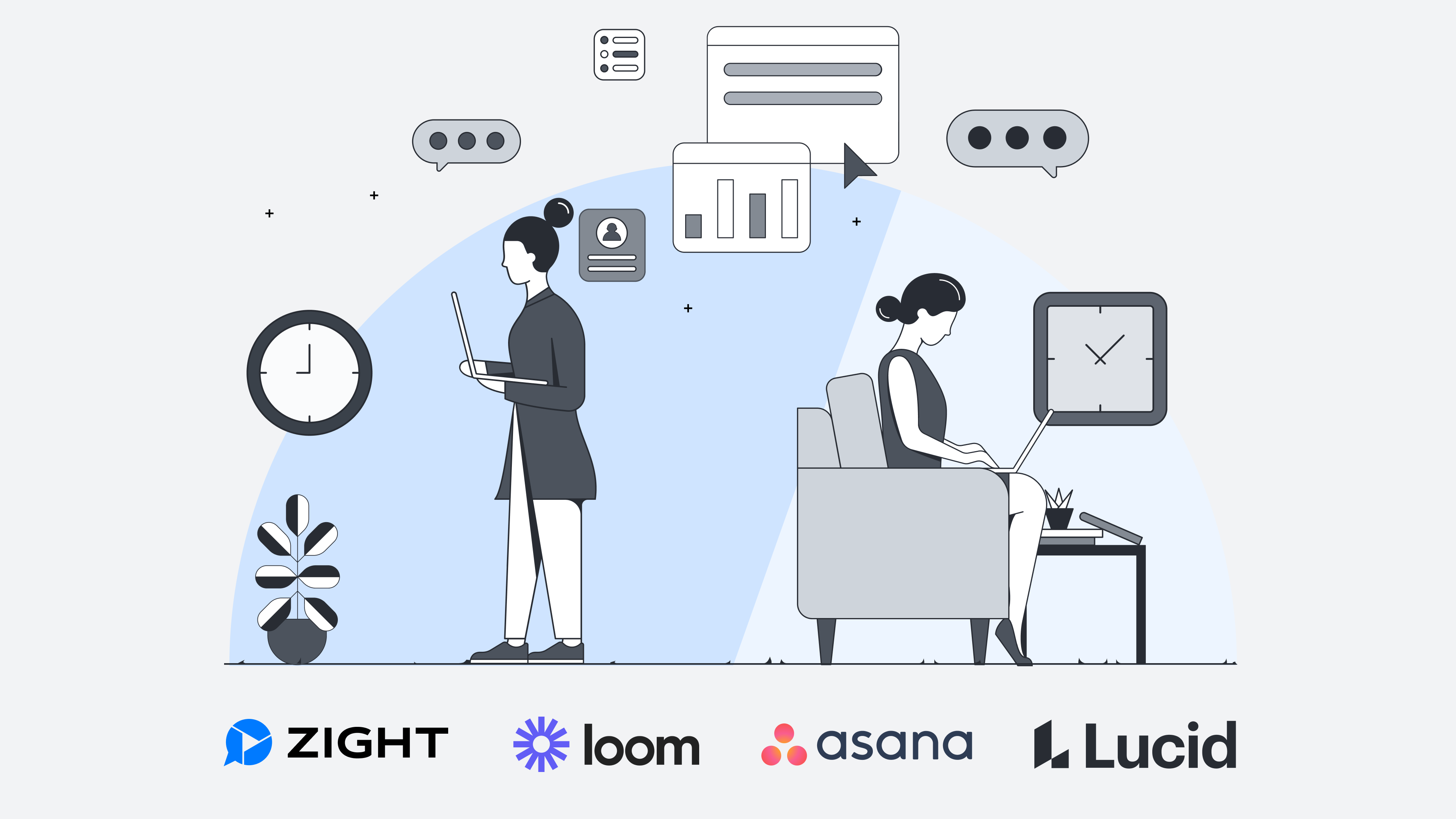
Asynchronous collaboration guide: How to improve team collaboration without another meeting
Reading time: about 17 min
Topics:
Content
Content
Key takeaways
-
Asynchronous collaboration is unscheduled, allowing teammates to contribute at separate times. Its primary benefits are combating meeting fatigue, increasing efficiency by giving time back for focused work, and accommodating different working locations, schedules, and collaboration styles.
-
Teams should treat async collaboration as the default method. Synchronous collaboration should be reserved for urgent issues, sensitive or controversial topics, intentional team-building, and kicking off novel or complex projects.
-
Many collaborative activities can be moved to an asynchronous format. Examples include ideation and brainstorming sessions, explaining or assigning work, giving status updates, and collecting feedback.
-
Successful asynchronous collaboration requires organizational changes. Teams need to redefine productivity by focusing on outcomes instead of hours/meetings. They also need a shared method for async collaboration, such as a visual collaboration solution.
Meeting fatigue is hitting organizations hard. The shift to remote work took away the ad-hoc collaboration and watercooler chats so many were accustomed to, prompting more meetings as managers attempted to adjust. Asana’s State of Work Innovation report found that since 2019, the time workers spend in unproductive meetings has doubled—to five hours per week. What’s more, Microsoft data shows that 30% of meetings now span multiple time zones, with meetings starting after 8 p.m. increasing 16% year over year.
Organizations know this meeting culture is draining their employees, zapping creativity, and wasting valuable time. They need a new approach to keep their teams aligned, engaged, and innovating—but what?
Some organizations have taken the approach of canceling all, or at least a large chunk, of their organization’s meetings. This approach can be effective, but only if you’ve intentionally enabled new ways for employees to share information, plan projects, and work together. If a planning session turns into a complex email thread with over 20 responses (and three different versions of an attached spreadsheet), have you really improved productivity or engagement? You may have solved the issue of “too many meetings” but created a whole new host of problems in the process.
Don’t be discouraged, though. Collaboration without meetings is possible. In fact, this type of collaboration, called asynchronous collaboration, can be far more effective than an endless string of meetings if approached strategically—that is, with the right mix of techniques and tools.
With insights from the companies leading the charge of asynchronous collaboration—Loom, Asana, Zight (formerly CloudApp), and our own team at Lucid—this guide will uncover the tried-and-true strategies that boost productivity, engagement, and innovation.
What is asynchronous collaboration?
Asynchronous collaboration (or async collaboration for short) is any unscheduled collaborative activity in which collaborators contribute at separate times, not in real time.
You’re likely already familiar with some forms of asynchronous communication, like sending emails or leaving comments in a shared document. Similarly, asynchronous meetings allow teammates to share ideas, leave messages, and give feedback at their convenience within a given timeframe. Everyone can contribute to a structured discussion via recorded videos, written updates, or shared documents.
Unlike synchronous meetings, which require participants to be present during a designated timeframe, asynchronous meetings allow participants to collaborate as their schedule permits, which can drastically reduce the number of meetings employees need to attend.
Benefits of asynchronous collaboration
We know asynchronous work reduces meeting fatigue, but the benefits extend far beyond that. In fact, asynchronous communication can be the fuel needed to keep organizations working effectively and, ultimately, improve the bottom line. A few data-backed benefits of asynchronous collaboration are that it:
Increases efficiency: Asana’s Anatomy of Work Index revealed that workers spend 58% of their time on “work about work” and 129 hours in unnecessary meetings each year. Async collaboration gives employees this precious time back.
“By enabling employees to review and respond to actions and messages in their own time, you’re giving them the flexibility and space to focus on skilled, high-impact work.” —Billy Blau, head of corporate and business development at Asana
Accommodates all collaboration styles: Lucid’s research shows that 56% of people feel that the loudest, most active voices dominate meetings. Async collaboration levels this playing field.
”Asynchronous work allows the deep thinker, the planner, the organizer, to more carefully and thoughtfully prepare their thoughts prior to a deadline and to do it at times that are most conducive to their superpowers.” —Scott Smith, CEO at Zight
Connects dispersed teams: Gallup data published in 2025 shows that among U.S. workers with remote-capable jobs, 51% have hybrid arrangements, 28% are exclusively remote, and only 21% work on-site. With asynchronous collaboration, dispersed teams can work together from anywhere without lost productivity.
“There's an expectation of flexibility in the modern workforce—in geographical location, what time you work, and whether you work from home or in the office. Asynchronous collaboration meets this expectation, allowing teams to keep projects moving forward in the way that works best for their schedules.” —Dan Lawyer, CPO at Lucid
Increases innovation: By removing location and time barriers, async collaboration allows organizations to capture more diverse perspectives and as a result, accelerate innovation. In fact, a Boston Consulting Group survey found that organizations with above-average diversity earned a whopping 45% of their revenue through innovation.
Promotes transparency: Organizations too often leave important explanations only for synchronous meetings. Anyone outside that meeting—perhaps those who were not yet pulled into the workstream or simply not available at that time—misses out on that content.
“Meetings often create a knowledge gap and force you to have duplicative conversations to bring everyone up to speed. Asynchronous communication enables the company to capture that knowledge in a documented and easily scalable format.” —Anique Drumright, COO at Loom
Improves team morale: When an employee's schedule isn’t dictated by meetings, they have more control over when they get their work done. And research shows that when employees feel trusted and have autonomy, they’re happier. According to Harvard Business Review, a 40% reduction in meetings not only made employees more productive but also increased satisfaction by 52%.
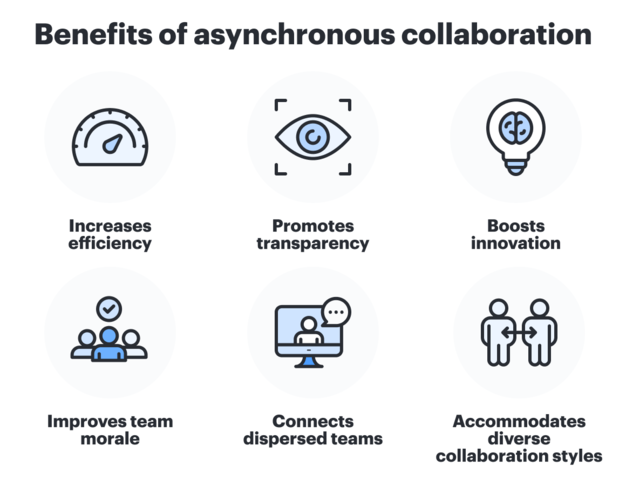
Asynchronous vs. synchronous collaboration: How to decide
Async collaboration can be a major time saver and morale booster, but it can’t replace all real-time conversation. So how can you determine what activities require a meeting and which are better done asynchronously?
As a general rule of thumb, asynchronous communication should be your default form of communication. In other words, if you can achieve the desired outcome without a meeting, then cancel (or don’t schedule) the meeting.
With that said, here are some criteria you can use to help you decide if the outcome you’re looking for requires live collaboration.
Asynchronous communication criteria
Ask yourself these questions to determine whether a meeting is best:
- How urgent is the matter? Asynchronous collaboration can introduce latency, especially as teams adjust to a new way of working in the early stages of implementing an asynchronous strategy. So if you need to resolve something ASAP, you might need to hop on a quick call.
- Is this a sensitive or controversial topic? Conversations that could potentially be emotional are best done in real time. Synchronous collaboration allows the participants to read body language, ask questions, and avoid any misunderstandings that could arise if the conversation were relayed via text.
- Are you trying to build team connections? This might go without saying, but intentional team-building activities are best when team members can talk, laugh, and connect face to face.
- Is the idea novel or complex? If you’re starting a project that’s completely new or different from anything your team has done before, they’ll likely have a lot of questions. If you anticipate a lot of discussion, you may want to kick off the project in real time. However, we do recommend using a format that will help you transition these projects easily into asynchronous work post-kickoff, like visual documentation of ideas, feedback, and project plans.
Use your organization’s values and mission to build a custom framework that helps your employees decide if a meeting is necessary. “For example, at Loom, we believe that explanation and presentation is a communication type best suited for asynchronous channels,” said Drumright. “Group decision-making and prioritization are examples of communication well-suited for a synchronous conversation.”
Which collaborative activities are better done asynchronously?
Need inspiration for collaborative activities that can be done asynchronously? Here are a few that, with the right tools and practices in place, can easily be done without a meeting:
Starting ideation sessions
Think of the live brainstorming sessions you’ve attended. It’s likely that most start with a few minutes for individuals to record ideas before everyone converges to discuss their ideas. Since that initial brainstorming is done independently anyway, you can save unnecessary meeting time by allowing team members to brainstorm and react to each other’s ideas asynchronously. Then, bring the team together to discuss the ideas live.
By beginning an ideation activity asynchronously, most team members will be better prepared to participate in rich discussions, especially those that need more time to think through ideas.

Explaining or assigning work
Unless you anticipate many questions or a need for live discussion, you can often explain a project asynchronously with visual documentation or recording a quick video through a platform like Loom or Zight. The assignee can view your explanation video when it works for them, and if the project is reassigned, you won’t need to spend more time reexplaining the same thing.
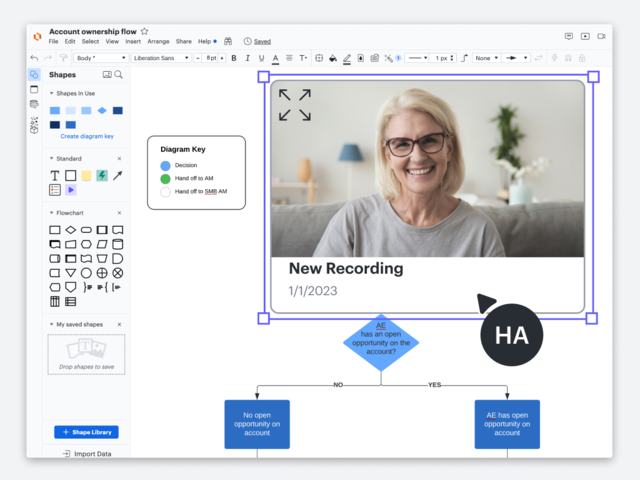
Providing status updates
Most status updates, such as quick project check-ins, can be done asynchronously. These types of meetings are often so ingrained in our weekly routines that we don’t stop to question their effectiveness or consider if they’re even needed.
With tools that help you visualize the work and tag teammates, you can show progress, highlight blockers, and stay aligned without as many meetings. Try a Kanban board or Scrum board template to collaboratively keep a pulse on projects.

Collecting feedback
It can be tempting to schedule a meeting to get feedback on an idea or plan, but you can collect more robust feedback—and in the appropriate context—when this is done asynchronously.
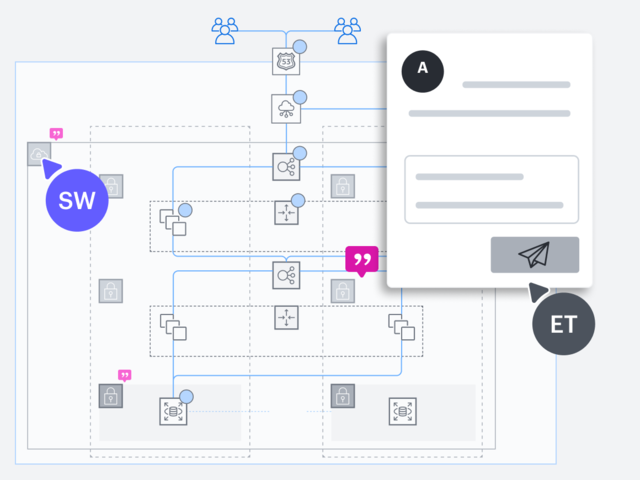
Remember, asynchronous collaboration should be part of a larger high-value collaboration strategy. The goal isn’t necessarily to replace as many meetings as you can but to work as efficiently as possible to achieve targeted outcomes. With the right tools and tactics, you should be able to transition between real-time conversation and asynchronous work seamlessly.
“Most of the time, you don’t need a meeting. But that doesn't mean that the content isn't important. It doesn’t mean that sharing ideas isn’t important. What it means is that there are better channels to do these things.” —Jarom Chung, VP of product management at Lucid
Best practices for asynchronous collaboration
For many organizations, asynchronous collaboration represents a major shift from traditional ways of working. This type of change requires intentional skill-building, culture reinforcement, change management, and of course, patience. To make asynchronous collaboration successful at your organization, keep these tips in mind.
Redefine productivity
Without regularly seeing people in the office or on video calls, it’s natural to worry about your team’s productivity. But don’t confuse the illusion of work with actual work being done. Instead of using hours worked or meetings attended as a baseline for productivity, set goals as a team and measure your progress toward those. This way, you build a critical level of trust with your team that empowers them to do their best work.
“My team has really specific goals we’re trying to accomplish, and it doesn’t matter how we get there, as long as we get there,” said Lawyer. “Establish together what the outcomes you expect are, and let the team use their autonomy to determine the best way to get there.”
Tip: To ensure roles and accountabilities are clear, try building out project plans and timelines in Lucidspark, our asynchronous collaboration tool. You can automatically transfer these over to common project management systems, such as Asana, Jira, or monday.com to keep everyone aligned.
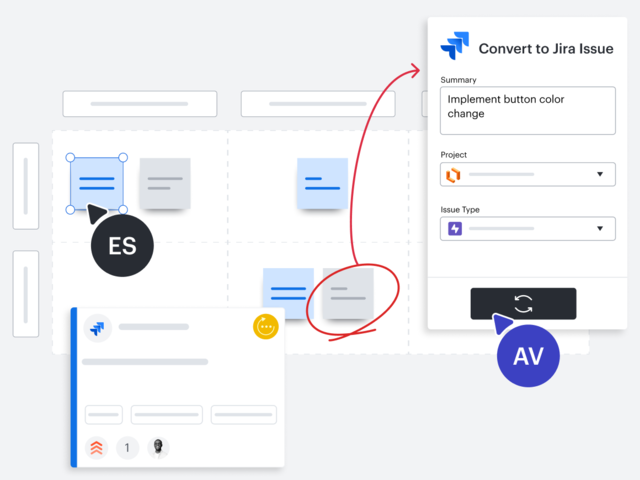
Go visual
Why do we often schedule meetings? It’s usually because it would be too complicated or time-consuming to type out the necessary context via email or chat. “Text-based communication is limited by its linear nature,” said Chung. “Meaning, trying to connect ideas and find important information across long chat threads is nearly impossible.”
But there’s a better way to add context, align, and communicate ideas quickly: visuals. Humans understand information quicker and retain it better when it’s presented visually.
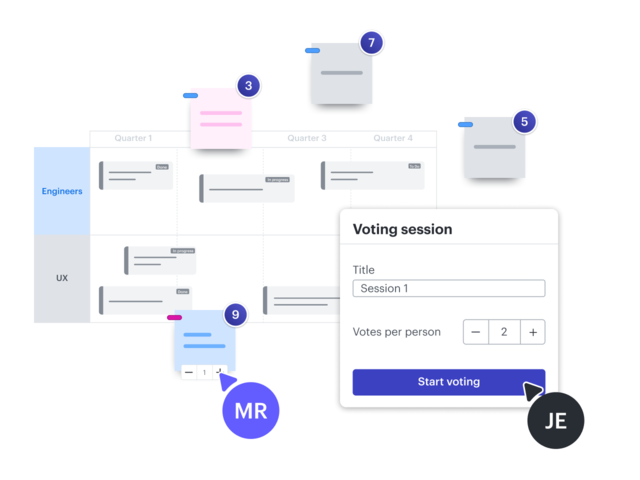
Whether you’re connecting ideas in a flowchart, tagging co-workers to review different parts of a diagram, or adding project info with sticky notes, tags, or links, asynchronous collaboration tools give every team member the context they need to make decisions and keep projects moving forward.
Document as you work
Documentation is necessary for distributing institutional knowledge, sharing information, and keeping team members aligned—whether or not they were part of a meeting.
Before you groan at the idea of laborious, time-consuming documentation, here’s some food for thought: Documentation can actually be a natural byproduct of collaboration—in other words, it can be practically effortless. How? By using the same collaborative platform for all your ideation sessions, prioritization, decision-making, project planning, and more, you’ll organically produce documentation that accelerates innovation.
With all your ideas, project context, and feedback centralized in one spot, you can easily answer questions and solve problems without taking time on anyone’s calendar.
Standardize team communication norms
To ensure everyone in the team is aligned on how to best collaborate asynchronously, take the time to build a team working agreement that details communication expectations and best practices. Be sure to build this collaboratively, so everyone has the chance to contribute and feel bought into this agreement. A sample team charter for working asynchronously may include:
- Each team member’s working hours, location, and time zone
- Tools to use for different types of collaboration (i.e., Slack for daily updates, Lucid for knowledge sharing, etc.)
- Communication agreements for different levels of urgency (i.e., deadlines to respond, how to indicate alignment, etc.)
- Links to common team resources or knowledge bases
A team charter not only helps set the right expectations for your current team, but it’s also a great way to get new team members up to speed quickly. In Lucid, you can even use team hubs as a home base for all team information.
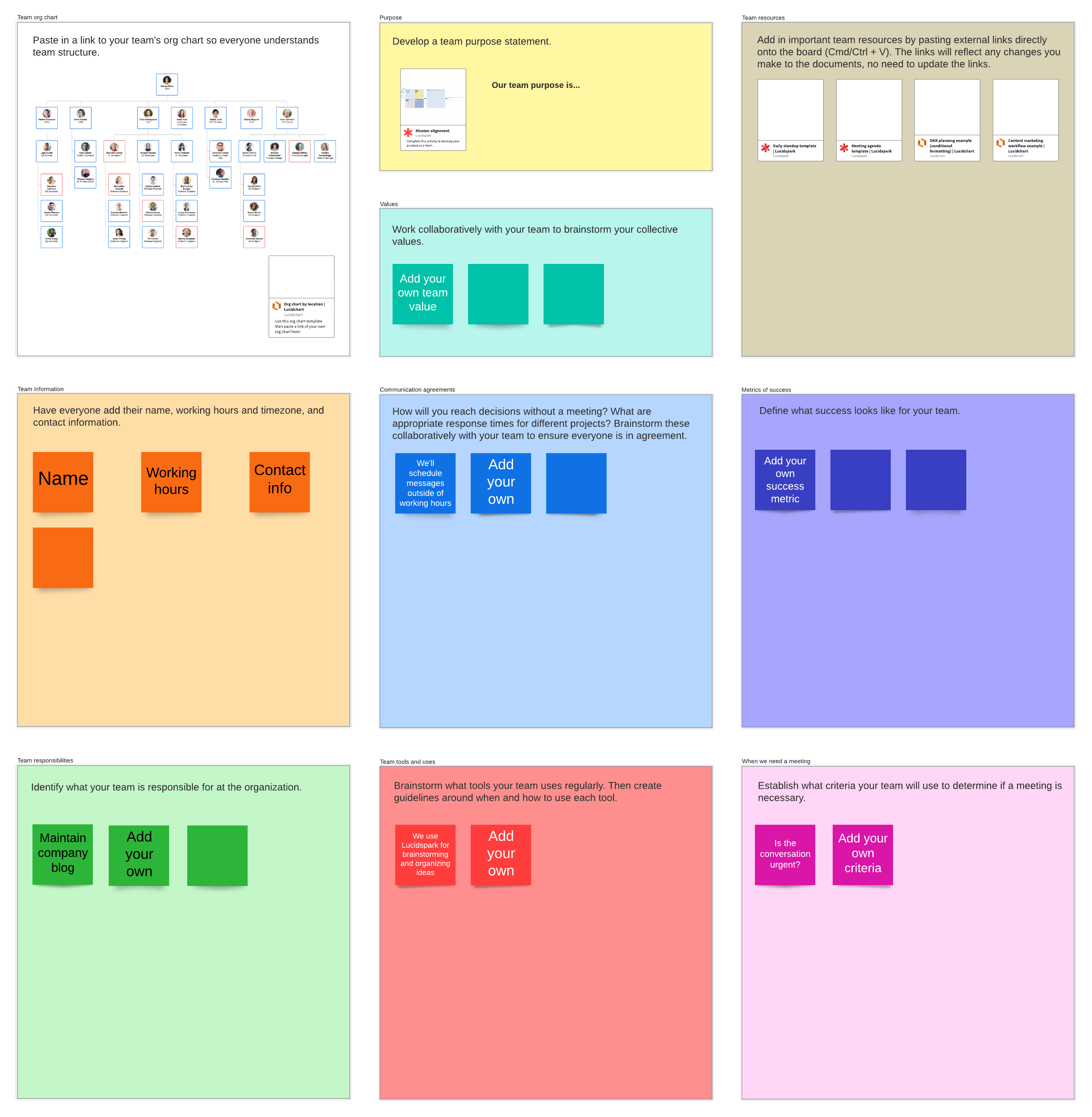
Reevaluate recurring meetings
Many recurring meetings, even if they were valuable at one point, can quickly turn into time sinks, disrupting focus and productivity.
“Many employees have a perception that management expects them to attend all these real-time conversations,” said Lawyer. “But in reality, these are just long-standing rituals that no one has bothered to question.”
Treat the transition to async as a trial-and-error process. That could mean picking a recurring meeting to cancel and trying in an asynchronous format. You may learn you can decrease the frequency of the meeting to quarterly instead of monthly or weekly, or you might not need to meet at all.
Lead by example
Most large-scale organizational change requires full leadership support to be successful. If you’re in a position to lead the shift to async, remember: It’s not enough to document your collaboration patterns; you must also emulate this behavior. For example, if you say you want to avoid the “always on” mentality that often accompanies flexible work, set the precedent that you will schedule, not send, messages outside of working hours—and stick to it. When you show you’re serious about this behavior, the rest of the team will follow suit.
“More often than not, there are advocates within an organization who are pushing for change,” said Smith. “They want to improve an existing dynamic, but without executive or managerial support, those changemakers may get frustrated and feel their efforts are being ignored.”
How to build an asynchronous collaboration tech stack
Asynchronous work requires the right tools to be effective—and we don’t just mean email. To properly share information and keep projects moving forward, look for tools that help add context, clarify ideas, and save you time.
When building out your asynchronous collaboration tech stack, these are the must-haves to ensure continuity, collaboration, and alignment.
Chat and messaging platforms
Many teams rely on messaging tools, like Slack or Microsoft Teams, for basic asynchronous communication. These tools allow you to chat with teammates, share updates, ask questions, and respond on your own time.
Using these tools, you can create groups or channels with those you frequently communicate with, making these tools a great way to reach alignment on easy-to-explain topics. If you notice your messages start to get too long or hard to follow, though, you’re probably better off using a different asynchronous tool.
Video recording tools
Video recordings are a great way to add context to projects without a meeting. With tools like Loom or Zight, you can send pre-recorded project explanations, status updates, or screenshares for teammates to watch at their convenience.
According to a Loom survey of office workers in the US and UK, nearly a third (32%) said the majority of digital work meetings could be replaced by asynchronous videos.
Not only are video recordings a great way to increase efficiency, but according to Jana Lass, VP of Marketing at Zight, they can also increase connection: “You can see a human face—making touchpoints more personal, more understandable, and consumable on everyone’s own time and schedule while avoiding many of the distractions that occur in an in-person work environment.”
Project and work management systems
Project and work management tools—like Jira, Asana, or Smartsheet—become especially important when working asynchronously because they allow teams to track work, assign tasks, and manage timelines without needing a meeting.
“One of the best things about Asana is that all communication is connected directly to work, making it easy to quickly understand who is doing what, and by when,” said Blau.
Cloud-based document storage and knowledge management tools
You can help your team get up-to-date information by using file storage tools like Google Drive and Microsoft OneDrive or knowledge sharing tools like Confluence and Notion. These cloud-based platforms allow team members from across the globe to access the files they need, when they need them.
Visual collaboration solutions
To truly help your team members stay aligned, informed, and engaged without a meeting, you’ll need a visual collaboration solution. Visual collaboration helps teams reach a shared understanding quickly and uncover deeper insights than if relying solely on verbal or text-based communication. Teams can use a visual collaboration solution to collaborate asynchronously on anything from brainstorming ideas to designing architectures or even planning new products.
The best part? By capturing all context in one place, the visual collaboration solution serves as a living blueprint for the organization, making it easy for teams to move seamlessly between meetings and async work without losing momentum.
It’s important to note that not all visual collaboration solutions are created equal. Look for solutions that integrate well into your workflow, leverage your existing data, and automate visualizations for you.

How to evaluate visual collaboration solutions
Identify your collaborative needs, compare options, and learn how to choose the best visual collaboration solution for your organization.
Get the guideNo matter what tools you decide to add to your asynchronous tech stack, it’s important that they integrate well with each other. Otherwise, you could end up with siloed information and inadvertently make async collaboration more complex, not less.
Take the next steps in your async collaboration journey
Asynchronous collaboration can be an incredibly powerful way to combat meeting fatigue while also increasing organizational efficiency, engagement, and innovation. The key is being intentional—not just canceling meetings and hoping for the best. With the right combination of tools and techniques, you can enable continuous collaboration, from real-time to asynchronous, idea to reality.
Leading organizations are turning to Lucid to increase async and real-time collaboration and alignment. With the combination of Lucidchart’s intelligent diagramming, Lucidspark’s flexible virtual whiteboard, and advanced capabilities through team hubs, Lucid AI, and Visual Activities, the Lucid Suite is the only visual collaboration solution that powers the entire project lifecycle.
In fact, Lucid customers save an average of 2.2 meetings per week by collaborating asynchronously with Lucid. And according to a commissioned study conducted by Forrester Consulting on behalf of Lucid, a composite organization using Lucid avoided 146,000 of follow-up meetings, saving $2.6M (The Total Economic Impact™ Of The Lucid Visual Collaboration Suite, May 2023).
Learn more about Lucid and the power of using visual collaboration for asynchronous work.

How visual collaboration benefits asynchronous work
Learn how a visual collaboration solution boosts clarity and alignment, whether you’re working together in real-time or asynchronously.
Learn moreAbout Lucid
Lucid Software is the leader in visual collaboration and work acceleration, helping teams see and build the future by turning ideas into reality. Its products include the Lucid Visual Collaboration Suite (Lucidchart and Lucidspark) and airfocus. The Lucid Visual Collaboration Suite, combined with powerful accelerators for business agility, cloud, and process transformation, empowers organizations to streamline work, foster alignment, and drive business transformation at scale. airfocus, an AI-powered product management and roadmapping platform, extends these capabilities by helping teams prioritize work, define product strategy, and align execution with business goals. The most used work acceleration platform by the Fortune 500, Lucid's solutions are trusted by more than 100 million users across enterprises worldwide, including Google, GE, and NBC Universal. Lucid partners with leaders such as Google, Atlassian, and Microsoft, and has received numerous awards for its products, growth, and workplace culture.
Related articles
Asynchronous collaboration tips from 4 organizations making it happen
Check out these experts’ proven tips for working more efficiently and effectively through asynchronous collaboration.
6 practical tips for more efficient collaboration
Here are some tangible ways to increase the efficiency and effectiveness of your team's collaboration.
How to focus your team on high-value collaboration
When collaboration is flowing, it's exciting—but too often, teams approach collaboration without any strategy or purpose, and poor results follow. The key to working consistently well together? Focusing on high-value collaboration.
10+ features to use in Lucidspark for maximum collaboration
Explore our powerful features that boost your team collaboration.
